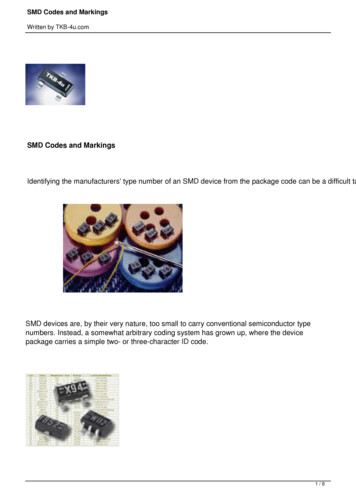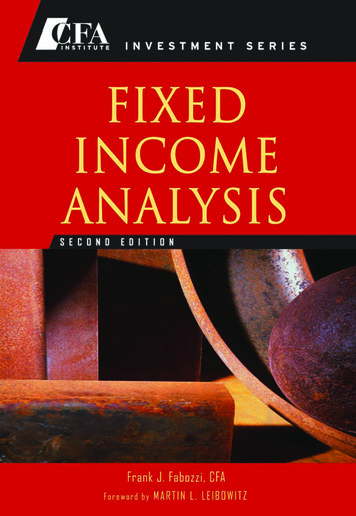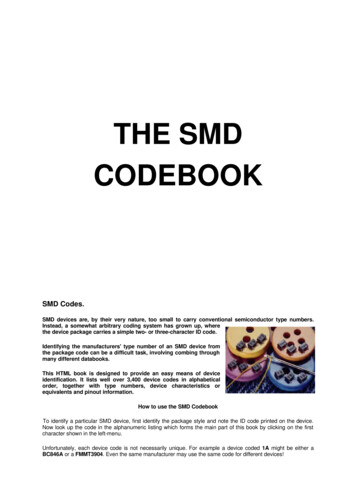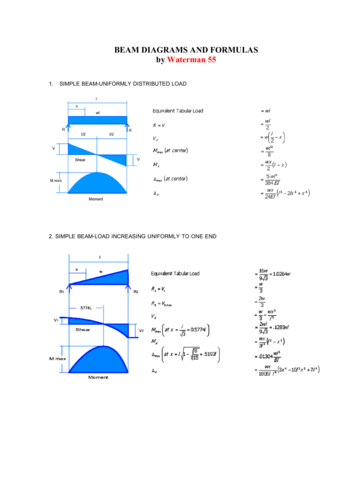
Transcription
Fixed-Income SecuritiesValuation, Risk Management and Portfolio StrategiesLionel MartelliniPhilippe PriauletandStéphane Priaulet
Fixed-Income Securities
Wiley Finance SeriesCountry Risk AssessmentMichael Bouchet, Ephraı̈m Clark and Bertrand GroslambertThe Simple Rules of Risk: Revisiting the Art of Risk ManagementMeasuring Market RiskKevin DowdAn Introduction to Market Risk ManagementBehavioural FinanceErik BanksKevin DowdJames MontierAsset Management: Equities DemystifiedShanta AcharyaAn Introduction to Capital Markets: Products, Strategies, ParticipantsHedge Funds: Myths and LimitsFrancois-Serge LhabitantThe Manager’s Concise Guide to RiskJihad S NaderSecurities Operations: A guide to trade and position managementModeling, Measuring and Hedging Operational RiskMonte Carlo Methods in FinanceAndrew M ChisholmMichael SimmonsMarcelo CruzPeter JäckelStructured Equity Derivatives: The Definitive Guide to Exotic Options and Structured NotesAdvanced Modelling in Finance Using Excel and VBAOperational Risk: Measurement and ModellingHarry KatMary Jackson and Mike StauntonJack KingAdvance Credit Risk Analysis: Financial Approaches and Mathematical Models to Assess, Price and Manage CreditRisk Didier Cossin and Hugues PirotteInterest Rate ModellingJessica James and Nick WebberVolatility and Correlation in the Pricing of Equity, FX and Interest-Rate OptionsRiccardo RebonatoRisk Management and Analysis vol. 1: Measuring and Modelling Financial RiskCarol Alexander (ed)Risk Management and Analysis vol. 2: New Markets and ProductsCarol Alexander (ed)Interest-Rate Option Models: Understanding, Analysing and Using Models for Exotic Interest-Rate Options (secondedition) Riccardo Rebonato
Fixed-Income SecuritiesValuation, Risk Management and Portfolio StrategiesLionel MartelliniPhilippe PriauletandStéphane Priaulet
c 2003Copyright John Wiley & Sons Ltd, The Atrium, Southern Gate, Chichester,West Sussex PO19 8SQ, EnglandTelephone ( 44) 1243 779777Email (for orders and customer service enquiries): cs-books@wiley.co.ukVisit our Home Page on www.wileyeurope.com or www.wiley.comAll Rights Reserved. No part of this publication may be reproduced, stored in a retrieval system or transmitted in anyform or by any means, electronic, mechanical, photocopying, recording, scanning or otherwise, except under the terms ofthe Copyright, Designs and Patents Act 1988 or under the terms of a licence issued by the Copyright Licensing AgencyLtd, 90 Tottenham Court Road, London W1T 4LP, UK, without the permission in writing of the Publisher. Requests tothe Publisher should be addressed to the Permissions Department, John Wiley & Sons Ltd, The Atrium, Southern Gate,Chichester, West Sussex PO19 8SQ, England, or emailed to permreq@wiley.co.uk, or faxed to ( 44) 1243 770620.This publication is designed to provide accurate and authoritative information in regard to the subject matter covered. Itis sold on the understanding that the Publisher is not engaged in rendering professional services. If professional advice orother expert assistance is required, the services of a competent professional should be sought.Other Wiley Editorial OfficesJohn Wiley & Sons Inc., 111 River Street, Hoboken, NJ 07030, USAJossey-Bass, 989 Market Street, San Francisco, CA 94103-1741, USAWiley-VCH Verlag GmbH, Boschstr. 12, D-69469 Weinheim, GermanyJohn Wiley & Sons Australia Ltd, 33 Park Road, Milton, Queensland 4064, AustraliaJohn Wiley & Sons (Asia) Pte Ltd, 2 Clementi Loop #02-01, Jin Xing Distripark, Singapore 129809John Wiley & Sons Canada Ltd, 22 Worcester Road, Etobicoke, Ontario, Canada M9W 1L1Wiley also publishes its books in a variety of electronic formats. Some content that appearsin print may not be available in electronic books.The views, thoughts and opinions expressed in this book are those of the authors in their individual capacities and shouldnot in any way be attributed to Philippe Priaulet as a representative, officer or employee of HSBC-CCF.The views, thoughts and opinions expressed in this book are those of the authors in their individual capacities and shouldnot in any way be attributed to Stéphane Priaulet as a representative, officer or employee of AXA.Library of Congress Cataloging-in-Publication DataMartellini, Lionel.Fixed-income securities : valuation, risk management, and portfolio strategies / LionelMartellini, Philippe Priaulet, and Stéphane Priauletp. cm.—(Wiley finance series)Includes bibliographical references and index.ISBN 0-470-85277-1 (pbk. : alk. paper)1. Fixed-income securities—Mathematical models. 2. Portfoliomanagement—Mathematical models. 3. Bonds—Mathematical models. 4. Hedging(Finance)—Mathematical models. I. Priaulet, Philippe. II. Priaulet, Stéphane. III. Title. IV.Series.HG4650.M367 2003332.63 2044—dc212003041167British Library Cataloguing in Publication DataA catalogue record for this book is available from the British LibraryISBN 0-470-85277-1Typeset in 10/12.5pt Times by Laserwords Private Limited, Chennai, IndiaPrinted and bound in Great Britain by Antony Rowe Ltd, Chippenham, WiltshireThis book is printed on acid-free paper responsibly manufactured from sustainable forestryin which at least two trees are planted for each one used for paper production.
To Adhara, Antonella, Calypso, Daphné, Isabelle and ManonTo our parents and familiesTo our friends
ContentsAbout the iPART IINVESTMENT ENVIRONMENT12Bonds and Money-Market Instruments1.1Bonds1.1.1General Characteristics of Bonds1.1.2Bonds by Issuers1.2Money-Market Instruments1.2.1Definition1.2.2The Role of the Central Bank1.2.3T-Bills1.2.4Certificates of Deposit1.2.5Bankers’ Acceptances1.2.6Commercial Papers1.2.7Interbank Deposits1.2.8Repo and Reverse Repo Market Instruments1.3End of Chapter Summary1.4References and Further Reading1.4.1Books and Papers1.4.2Websites and Others1.5Problems1.5.1Problems on Bonds1.5.2Problems on Money-Market Instruments1.6Appendix: Sector Breakdown of the Euro, the UK and the JapanCorporate Bond Markets3331725252526282929303032333333343436Bond Prices and Yields2.1Introduction to Bond Pricing2.2Present Value Formula41414337
alue of MoneyThe Mathematics of DiscountingNominal versus Real Interest RatesTime Basis and CompoundingFrequency Conventions2.2.5Continuous CompoundingTaxonomy of Rates2.3.1Coupon Rate and Current Yield2.3.2Yield to Maturity2.3.3Spot Zero-Coupon (or Discount) Rate2.3.4Forward Rates2.3.5Bond Par YieldEnd of Chapter SummaryReferences and Further ReadingProblems4343454647494949515254545455PART IITERM STRUCTURE OF INTEREST RATES34Empirical Properties and Classical Theories of the Term Structure3.1Definition and Properties of the Term Structure3.1.1What Kind of Shape Can It Take?3.1.2How Does It Evolve over Time?3.2Classical Theories of the Term Structure3.2.1The Pure Expectations Theory3.2.2The Pure Risk Premium Theory3.2.3The Market Segmentation Theory3.2.4The Biased Expectations Theory:An Integrated Approach3.2.5Illustration and Empirical Validation3.2.6Summary and Extensions3.3End of Chapter Summary3.4References and Further Reading3.4.1On the Empirical Behavior of the Yield Curve3.4.2On the Principal Component Analysisof the Yield Curve3.4.3On the Classical Theories of the Term Structureof Interest Rates3.5ProblemsDeriving the Zero-Coupon Yield Curve4.1Deriving the Nondefault Treasury Zero-Coupon Yield Curve4.1.1How to Select a Basket of Bonds?4.1.2Direct Methods4.1.3Indirect 03
ixContents4.24.34.44.54.64.7Deriving the Interbank Zero-Coupon Rate Curve4.2.1How to Select the Basket of Instruments?4.2.2Interpolation Methods4.2.3Least Squares Methods Based on Rates4.2.4Least Squares Methods Based on PricesDeriving Credit Spread Term Structures4.3.1Disjoint Methods4.3.2Joint MethodsEnd of Chapter SummaryReferences and Further ReadingProblemsAppendix: A Useful Modified Newton’s Algorithm130130132132133136136137142144146155PART IIIHEDGING INTEREST-RATE RISK5Hedging Interest-Rate Risk with Duration5.1Basics of Interest-Rate Risk: Qualitative Insights5.1.1The Five Theorems of Bond Pricing5.1.2Reinvestment Risk5.1.3Capital Gain Risk5.1.4Qualifying Interest-Rate Risk5.2Hedging with Duration5.2.1Using a One-Order Taylor Expansion5.2.2Duration, Duration and Modified Duration5.2.3How to Hedge in Practice?5.3End of Chapter Summary5.4References and Further 41651661671671701731751761761761776Beyond Duration6.1Relaxing the6.1.16.1.26.1.36.2Relaxing the6.2.16.2.21821821821851871881886.3Assumption of a Small ShiftUsing a Second-Order Taylor ExpansionProperties of ConvexityHedging MethodAssumption of a Parallel ShiftA Common PrincipleRegrouping Risk Factors througha Principal Component Analysis6.2.3Hedging Using a Three-Factor Modelof the Yield CurveEnd of Chapter Summary192195199
xContents6.46.5References and Further ReadingProblems200201PART IVINVESTMENT STRATEGIES789Passive Fixed-Income Portfolio Management7.1Straightforward Replication7.2Replication by Stratified Sampling7.3Tracking-Error Minimization7.3.1Optimization Procedure7.3.2Bond Return Covariance Matrix Estimation7.4Factor-Based Replication7.5Derivatives-Based Replication7.6Pros and Cons of Stratified Sampling versusTracking-Error Minimization7.7End of Chapter Summary7.8References and Further Reading7.8.1Books and Papers7.8.2Websites7.9ProblemsActive Fixed-Income Portfolio Management8.1Market Timing: Trading on Interest-Rate Predictions8.1.1Timing Bets on No Change in the Yield Curveor “Riding the Yield Curve”8.1.2Timing Bets on Interest-Rate Level8.1.3Timing Bets on Specific Changes in theYield Curve8.1.4Scenario Analysis8.1.5Active Fixed-Income Style Allocation Decisions8.2Trading on Market Inefficiencies8.2.1Trading within a Given Market: The BondRelative Value Analysis8.2.2Trading across Markets: Spreadand Convergence Trades8.3End of Chapter Summary8.4References and Further Reading8.4.1On Active Fixed-Income Strategies8.4.2On Active Asset Allocation Decisions8.4.3Others8.5ProblemsPerformance Measurement on Fixed-Income Portfolios9.1Return Measures9.1.1Arithmetic Rate of Return9.1.2Geometric Rate of 93293294
xiContents9.29.39.49.59.6Risk-Adjusted Performance Evaluation9.2.1Absolute Risk-Adjusted Performance Evaluation9.2.2Relative Risk-Adjusted Performance EvaluationApplication of Style Analysis to Performance Evaluationof Bond Portfolio Managers: An Example9.3.1Alpha Analysis9.3.2Passive Versus Active ManagersEnd of Chapter SummaryReferences and Further Reading9.5.1Books and 5315316316PART VSWAPS AND FUTURES10Swaps10.1Description of Swaps10.1.1Definition10.1.2Terminology and Conventions10.2Pricing and Market Quotes10.2.1Pricing of Swaps10.2.2Market Quotes10.3Uses of Swaps10.3.1Optimizing the Financial Conditions of a Debt10.3.2Converting the Financial Conditions of a Debt10.3.3Creating New Assets Using Swaps10.3.4Hedging Interest-Rate Risk Using Swaps10.4Nonplain Vanilla Swaps10.4.1Accrediting, Amortizing and Roller Coaster Swaps10.4.2Basis Swap10.4.3Constant Maturity Swap and ConstantMaturity Treasury Swap10.4.4Forward-Starting Swap10.4.5Inflation-Linked Swap10.4.6Libor in Arrears Swap10.4.7Yield-Curve Swap10.4.8Zero-Coupon Swap10.5End of Chapter Summary10.6References and Further Reading10.6.1Books and 6346347347
xiiContents11Forwards and Futures11.1Definition11.2Terminology, Conventions and Market Quotes11.2.1Terminology and Conventions11.2.2Quotes11.3Margin Requirements and the Role of the Clearing House11.4Conversion Factor and the Cheapest-to-Deliver Bond11.4.1The Cheapest to Deliver on the Repartition Date11.4.2The Cheapest to Deliver beforethe Repartition Date11.5Pricing of Forwards and Futures11.5.1Forward-Spot Parity or How to Pricea Forward Contract?11.5.2The Forward Contract Payoff11.5.3Relation between Forward and Futures Prices11.6Uses of Forwards and Futures11.6.1Pure Speculation with Leverage Effect11.6.2Fixing Today the Financial Conditions of a Loanor Investment in the Future11.6.3Detecting Riskless Arbitrage OpportunitiesUsing Futures11.6.4Hedging Interest-Rate Risk Using Futures11.7End of Chapter Summary11.8References and Further Reading11.8.1Books and Papers11.8.2Websites of Futures Markets and of the FuturesIndustry Association11.9Problems11.10 Appendix: Forward and Futures Prices Are IdenticalWhen Interest Rates Are 365366367368370371371371372375PART VIMODELING THE TERM STRUCTURE OF INTEREST RATES AND CREDIT SPREADS12Modeling the Yield Curve Dynamics12.1The Binomial Interest-Rate Tree Methodology12.1.1Building an Interest-Rate Tree12.1.2Calibrating an Interest-Rate Tree12.2Continuous-Time Models12.2.1Single-Factor Models12.2.2Multifactor Models12.3Arbitrage Models381382382384387388392396
xiiiContents12.3.112.412.512.612.712.813A Discrete-Time Example: Ho and Lee’sBinomial Lattice12.3.2Arbitrage Models in Continuous TimeEnd of Chapter SummaryReferences and Further ReadingProblemsAppendix 1: The Hull and White Trinomial Lattice12.7.1Discretizing the Short Rate12.7.2Calibrating the Lattice to the CurrentSpot Yield Curve12.7.3Option PricingAppendix 2: An Introduction to StochasticProcesses in Continuous Time12.8.1Brownian Motion12.8.2Stochastic Integral12.8.3Stochastic Differential Equations (SDE)12.8.4Asset Price Process12.8.5Representation of Brownian Martingales12.8.6Continuous-Time Asset Pricing12.8.7Feynman–Kac Formula12.8.8Application to Equilibrium Modelsof the Term StructureModeling the Credit Spreads Dynamics13.1Analyzing Credit Spreads13.1.1Ratings13.1.2Default Probability13.1.3The Severity of Default13.2Modeling Credit Spreads13.2.1Structural Models13.2.2Subsequent Models13.2.3Reduced-Form Models13.2.4Historical versus Risk-AdjustedProbability of Default13.3End of Chapter Summary13.4References and Further Reading13.4.1Books and 1441442446448450452453453454455PART VIIPLAIN VANILLA OPTIONS AND MORE EXOTIC DERIVATIVES14Bonds with Embedded Options and Options on Bonds14.1Callable and Putable Bonds459459
tional Aspects14.1.2Pricing14.1.3OAS Analysis14.1.4Effective Duration and ConvexityConvertible Bonds14.2.1Institutional Aspects14.2.2Valuation of Convertible Bonds14.2.3Convertible ArbitrageOptions on Bonds14.3.1Definition14.3.2Uses14.3.3PricingEnd of Chapter SummaryReferences and Further Reading14.5.1On Callable and Putable Bonds14.5.2On Convertible Bonds14.5.3On Options on BondsProblemsAppendix: Bond Option Prices in the Hulland White (1990) Model14.7.1Call on Zero-Coupon Bond14.7.2Call on Coupon BondOptions on Futures, Caps, Floors and Swaptions15.1Options on Futures15.1.1Definition and Terminology15.1.2Pricing and Hedging Options on Futures15.1.3Market Quotes15.1.4Uses of Futures Options15.2Caps, Floors and Collars15.2.1Definition and Terminology15.2.2Pricing and Hedging Caps, Floors and Collars15.2.3Market Quotes15.2.4Uses of Caps, Floors and Collars15.3Swaptions15.3.1Definition and Terminology15.3.2Pricing and Hedging Swaptions15.3.3Market Quotes15.3.4Uses of Swaptions15.4End of Chapter Summary15.5References and Further Reading15.5.1Books and 28529529
xvContents15.715.815.915.1015.1116Appendix 1: Proof of the Cap and FloorFormulas in the Black (1976) ModelAppendix 2: Proof of the Swaption Formulain the Black (1976) ModelAppendix 3: Forward and Futures Option Prices Written on T-Bondand Libor in the Hull and White (1990) Model15.9.1Options on Forward Contracts15.9.2Options on Futures ContractsAppendix 4: Cap, Floor and Swaption Prices in the Hulland White (1990) Model15.10.1Cap and Floor15.10.2SwaptionAppendix 5: Market Models (BGM/Jamshidian Approach)15.11.1Why Define New Variables?15.11.2Building New Variables15.11.3The Dynamics of L(t, θ) and K(t, t θ)15.11.4Pricing of Caps15.11.5Calibration of the ModelExotic Options and Credit Derivatives16.1Interest-Rate Exotic Options16.1.1Barrier Caps and Floors16.1.2Bounded Caps, Floors, Barrier Caps and Floors16.1.3Cancelable Swaps16.1.4Captions and Floortions16.1.5Choosercaps and Flexicaps-and-Floors16.1.6Contingent Premium Caps and Floors16.1.7Extendible Swaps16.1.8Incremental Fixed Swaps16.1.9Index Amortizing Bonds and Swaps16.1.10Marked-to-Market Caps16.1.11Moving Average Caps and Floors16.1.12N-Caps and Floors16.1.13Q-Caps and Floors16.1.14Range Accrual Swaps16.1.15Ratchet Caps and Floors16.1.16Reflex Caps and Floors16.1.17Rental Caps and Floors16.1.18Rolling Caps and Floors16.1.19Spread Options16.1.20Subsidized Swaps16.1.21Pricing and Hedging Interest-Rate Exotic 561562562563563565
xviContents16.216.316.416.516.616.7Credit Derivatives16.2.1The Significance of Credit Derivatives16.2.2Types of Credit DerivativesEnd of Chapter SummaryReferences and Further Reading16.4.1On Interest-Rate Exotic Options16.4.2On Credit Derivatives16.4.3On Numerical Methods (See the Appendix 2)16.4.4Websites and OthersProblemsAppendix 1: Pricing and Hedging Barrier Caps and Floorsin the Black Model16.6.1Barrier Cap Formulas16.6.2Barrier Floor Formulas16.6.3Barrier Cap and Floor GreeksAppendix 2: Numerical Methods16.7.1Monte Carlo Simulations16.7.2Finite-Difference 83583585PART VIIISECURITIZATION17Mortgage-Backed Securities17.1Description of MBSs17.1.1Definition17.1.2The Amortization Mechanism17.1.3The Prepayment Feature17.1.4Typology of MBS17.2Market Quotes and Pricing17.2.1Market Quotes17.2.2Pricing of MBS17.3End of Chapter Summary17.4References and Further Reading17.4.1Books and 59859960060360460460560518Asset-Backed Securities18.1Description of ABSs18.1.1Definition18.1.2Credit Enhancement18.1.3Cash-Flow Structure607607607607608
xviiContents18.218.318.418.518.6Market Quotes and PricingCAT Bonds and CAT DerivativesEnd of Chapter SummaryReferences and Further ReadingProblems610612615615616Subject Index617Author Index629
About the AuthorsLionel Martellini is an Assistant Professor of Finance at the Marshall Schoolof Business, University of Southern California, where he teaches “fixed-incomesecurities” at the MBA level. He is also a research associate at the EDHEC Riskand Asset Management Research Center, and a member of the editorial boardsof The Journal of Bond Trading and Management and The Journal of AlternativeInvestments. He holds master’s degrees in business administration, economics,statistics and mathematics, as well as a Ph.D. in finance from the Haas School ofBusiness, University of California at Berkeley. His expertise is in derivatives valuation and optimalportfolio strategies, and his research has been published in leading academic and practitioners’journals. He has also served as a consultant for various international institutions on these subjects.Philippe Priaulet is a fixed-income strategist in charge of derivatives strategies forHSBC. His expertise is related to fixed-income asset management and derivativespricing and hedging, and his research has been published in leading academicand practitioners’ journals. Formerly, he was head of fixed-income research in theResearch and Innovation Department of HSBC-CCF. He holds master’s degreesin business administration and mathematics as well as a Ph.D. in financial economics from University Paris IX Dauphine. Member of the editorial board of TheJournal of Bond Trading and Management, he is also an associate professor in theDepartment of Mathematics of the University of Evry Val d’Essonne and a lecturer at ENSAE,where he teaches “fixed-income securities” and “interest rate modeling”.Stéphane Priaulet is senior index portfolio manager in the Structured Asset Management Department at AXA Investment Managers. Previously, he was headof quantitative engineering in The Fixed Income Research Department at AXAInvestment Managers. He also teaches “fixed-income securities” as a part-timelecturer at the University Paris Dauphine. He is a member of the editorial boardof The Journal of Bond Trading and Management, where he has published several research papers. He holds a diploma from the HEC School of Management,with specialization in economics and finance, and has completed postgraduatestudies in mathematics at the University Pierre et Marie Curie (Paris VI), withspecialization in stochastic calculus.
PrefaceDebt instruments have evolved beyond the straight bonds with simple cash-flow structures tosecurities with increasingly complex cash-flow structures that attract a wider range of investorsand enable borrowers to reduce their costs of raising funds. In order to effectively employ portfoliostrategies that may control interest-rate risk and/or enhance returns, investors must understand theforces that drive bond markets and the valuation of these complex securities and their derivativeproducts.What this Book is AboutThis book is about interest rates and risk management in bond markets. It develops insights intodifferent bond portfolio strategies and illustrates how various types of derivative securities canbe used to shift the risks associated with investing in fixed-income securities. It also providesextensive coverage on all sectors of the bond market and the techniques for valuing bonds.While there certainly exists an impressive list of books that cover in some detail the issues relatedto bond and fixed-income derivative pricing and hedging, we just could not find, in existingtextbooks, the same level of depth in the analysis of active and passive bond portfolio strategies.This is perhaps unfortunate because we have learnt a lot about active and passive bond portfoliostrategies in the past thirty years or so. While no financial economist or practitioner in the industrywould claim they have found a reliable model for the valuation of stocks, we indeed have reacheda fairly high level of understanding on how, why and when to invest in bonds.We have written this book in an attempt to achieve the following goal: provide the reader witha detailed exposure to modern state-of-the-art techniques for bond portfolio management. Wecover not only traditional techniques used by mutual fund managers in the fixed-income area butalso advanced techniques used by traders and hedge fund managers engaged in fixed-income orconvertible arbitrage strategies.More specifically, we attempt to achieve the following: Describe important financial instruments that have market values that are sensitive to interestrate movements. Specifically, the course will survey the following fixed-income assets andrelated securities: zero-coupon government bonds, coupon-bearing government bonds, corporate bonds, exchange-traded bond options, bonds with embedded options, floating-ratenotes, caps, collars and floors, floating-rate notes with embedded options, forward contracts,interest-rate swaps, bond futures and options on bond futures, swaptions, credit derivatives,mortgage-backed securities, and so on. Develop tools to analyze interest-rate sensitivity and value fixed-income securities. Specifically, the course will survey the following tools for active and passive bond management:
xxiiPrefaceconstruction of discount functions, duration, convexity, and immunization; binomial trees foranalysis of options; hedging with bond futures, using models of the term structure for pricingand hedging fixed-income securities; models for performance evaluation; systematic approachto timing; valuation of defaultable bonds; bonds with embedded options; interest-rate derivatives, and so on.For the ReaderThis book is original in that it aims at mixing theoretical and practical aspects of the question ina systematic way. This duality can be traced back to the professional orientations of the authors,who are active in both the academic and the industrial worlds. As such, this book can be of interestto both students and professionals from the banking industry. To reach the goal of providing thereader with a practical real-world approach to the subject, we have ensured that the book containsdetailed presentations of each type of bond and includes a wide range of products. Extensivediscussions include not only the instruments but also their investment characteristics, the state-ofthe art technology for valuing them and portfolio strategies for using them. We make a systematicuse of numerical examples to facilitate the understanding of these concepts.The level of mathematical sophistication required for a good understanding of most of the materialis relatively limited and essentially includes basic notions of calculus and statistics. When moresophisticated mathematical tools are needed, they are introduced in a progressive way and mostreally advanced material has been placed in dedicated appendices. As a result, the book is suitedto students and professionals with various exposure to, or appetite for, a more quantitative treatment of financial concepts. Generally speaking, the material devoted to the modeling of the termstructure and the pricing of interest-rate derivatives is more technical, even though we have consistently favored intuition and economic analysis over mathematical developments. Appendix 2 toChapter 12, devoted to advanced mathematical tools for term-structure modeling, can be skipped bythe nonquantitatively oriented reader without impeding his/her ability to understand the remainingsix chapters.For the InstructorThe book is complemented with a set of problems (more than 200 of them) and their solutions,posted on a dedicated website (www.wiley.co.uk/martellini), as well as a complete set of Excelillustrations and PowerPoint slides (more than 400 of them). This makes it ideally suited fora typical MBA audience, in the context of a basic or more advanced “Fixed-Income Security”course. It can also be used by undergraduate, graduate and doctoral students in finance.The first nine chapters offer a detailed analysis of all issues related to bond markets, includinginstitutional details, methods for constructing the yield curve and hedging interest-rate risk, as wellas a detailed overview of active and passive bond portfolio strategies and performance evaluation.As such, they form a coherent whole that can be used for a shorter quarter course on the subject.Chapters 10 to 18 cover a whole range of fixed-income securities, including swaps, futures, options,and so on. This second half of the book provides a self-contained study of the modern approachfor pricing and hedging fixed-income securities and interest-rate options. The text mostly focuseson the binomial approach to the pricing of fixed-income derivatives, providing cutting-edge theory
xxiiiPrefaceand technique, but continuous-time models are also discussed and put in context. This materialcan be taught either in the context of an advanced fixed-income class or as the second half of ageneral semester course on fixed-income securities.By the way, we are aware that “Martellini, Priaulet and Priaulet” is a long, funny-soundingreference name. Please feel free to refer our textbook to your students as MPP, or MP2 (MPsquared).
AcknowledgmentsWe would like to express our gratitude to a number of people who have provided invaluablefeedback at different stages of the manuscript or helped in the publication process. We are particularly grateful to Noel Amenc, Tarek Amyuni, Yoann Bourgeois, Vicent Altur Brines, MooradChoudhry, Christophe Huyghues-Despointes, Yonathan Ebguy, Rémy Lubeth, Victoria Moore,Moez Mrad, Daad Abou Saleh, Alexandre Van den Brande and Franck Viollet for their commentsand suggestions.
NotationThis glossary contains some standard definitions and notations that are used throughout the book. α is the risk-adjusted expected return on a bond portfolio. β0 , β1 and β2 are the parameters measuring respectively the level, slope and curvature ofthe term structure in the Nelson and Siegel (1987) model. β0 , β1 , β2 and β3 are the parameters measuring respectively the level, slope and curvaturesof the term structure in the Svensson (1994) model. (delta) is a measure of the first-order sensitivity of an option price with respect to smallchanges in the value of the underlying rate or asset. γ (gamma) is a measure of the second-order sensitivity of an option price with respect tosmall changes in the value of the underlying rate or asset. γ (t, T ) is the volatility at date t of the instantaneous forward rate f (t, T ). σ (t, T ) is the volatility at date t of the zero-coupon bond B (t, T ). (x ) is the distribution function of a standardized Gaussian, that is, it is the probability thata normally distributed variable with a mean of zero and a standard deviation of 1 is lessthan x . (x ) is the first derivative of with respect to x . ν (vega) is a measure of the first-order sensitivity of an option price with respect to smallchanges in the volatility of the underlying rate or asset. ρ (rho) is a measure of the first-order sensitivity of an option price with respect to smallchanges in the interest rate. θ (theta) is a measure of the first-order sensitivity of an option price with respect to smallchanges in time to maturity. ACt is the accrued interest on a bond at date t. BPV is the basis point value, which is the change in the bond (or bond portfolio) given abasis point change in the bond’s (or bond portfolio) yield. B(t, T ) is the price at date t of
Relative Value Analysis 269 8.2.2 Trading across Markets: Spread and Convergence Trades 276 8.3 End of Chapter Summary 282 8.4 References and Further Reading 283 8.4.1 On Active Fixed-Income Strategies 283 8.4.2 On Active Asset Allocation Decisions 284 8.4.3 Others 286 8.5 Problems 286 9 Performance Measurement on Fi










